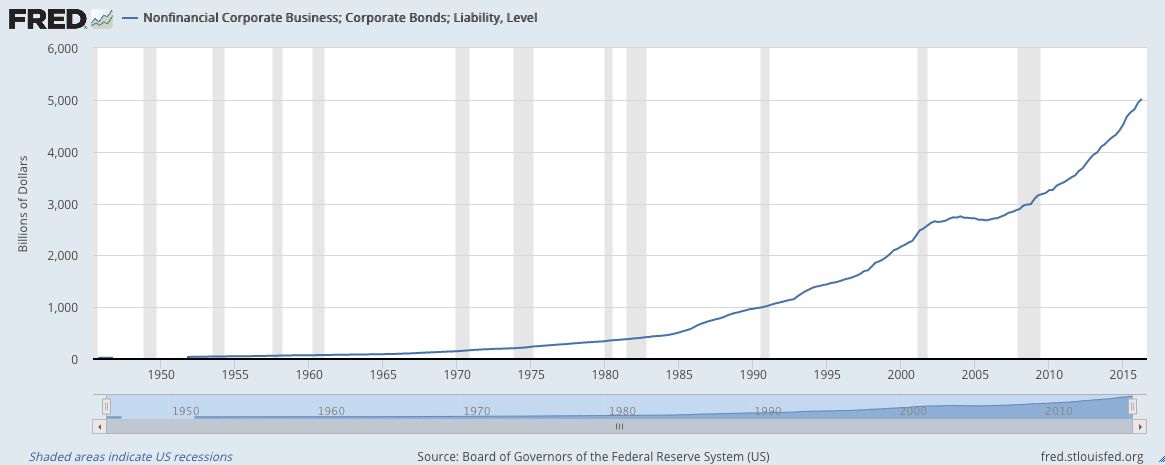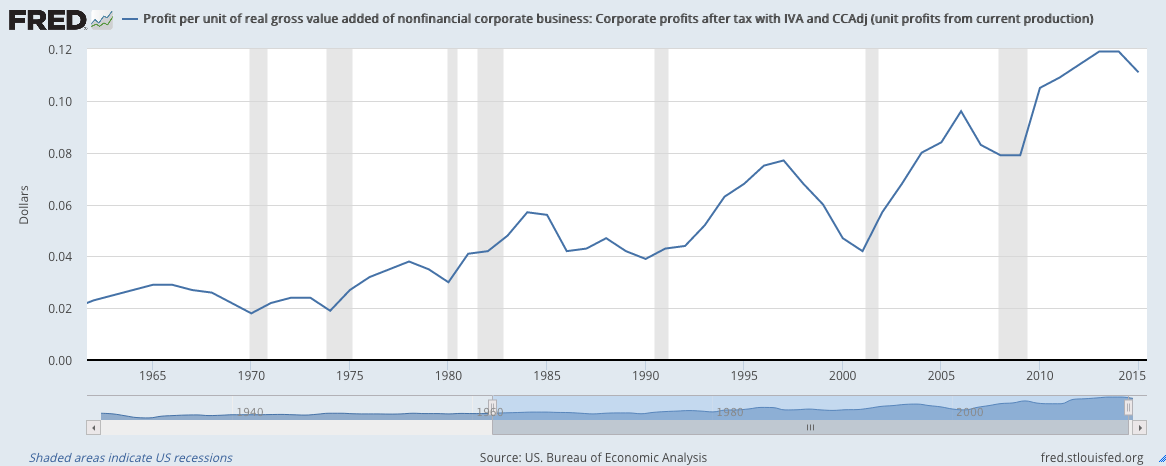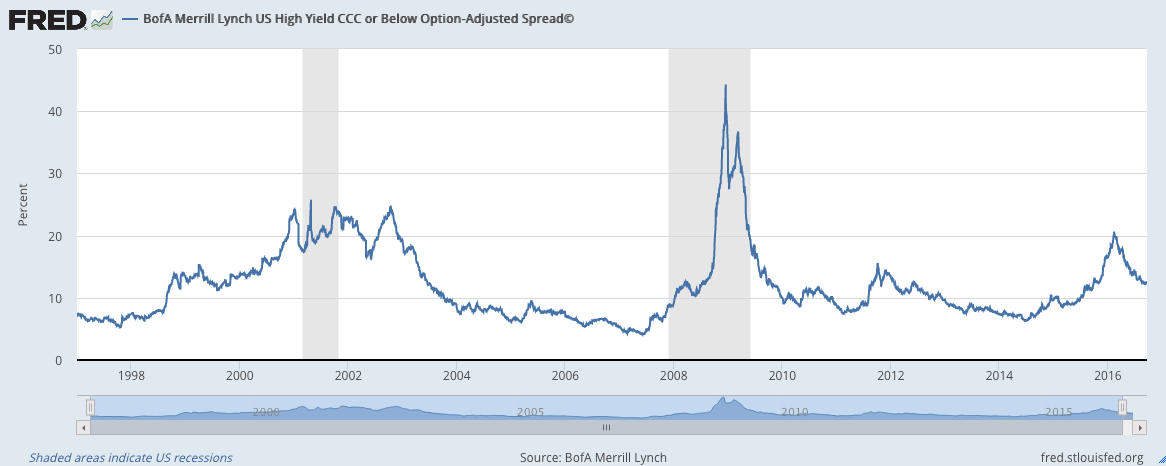This is a follow up on the numerous articles I have been writing on bonds.
I spoke about ‘cheap money’ here.
And now I am going to share the research and information that I have been working on.
To be fair, I have been working on this for a while. It’s not some idea I just came up with last week.
Once I share the following information with you, I believe you will really understand what is about to happen in the US and the world.
Of course, I can’t guarantee anything, but we can definitively identify where risk is in the market today.
Another very important thing to keep in mind… When the market thinks something is risky, then the price is built in. That means that when people’s opinion of something is negative, there is not a large risk of collapse… because it’s already expected to fail!
Conversely, when people have confidence in something, there is very little thought about failure. Just like the housing market in 2007 or the internet bubble in 2000 or even the thoughts about Brexit…
When the majority doesn’t expect something to happen, then the results are that much more devastating.
That’s what bonds are today.
Bonds are debt that companies have taken on in order to expand their operations. Governments also sell bonds to finance any project they want to pursue.
So, companies and governments have taken on debt because of cheap money – this means that they can borrow money for cheap prices. Companies and governments can do this because of artificially suppressed interest rates. Central banks throughout the world have kept interest rates low to battle against deflation of currencies and in turn combat a potential financial collapse.
These companies and governments must pay back these bonds to the investors who have lent them money. The only time these bonds don’t have to be repaid is if the borrower goes bankrupt.
Now, governments and companies won’t go bankrupt… right?
Well… only time will tell. However we can look at statistics now to forecast what the future will hold.
First, I am going to show you two different charts that are essentially saying the same thing. These two charts are from the Federal Reserve Economic Research website – it should be reliable.
These two charts look a little different, but they essentially say the same thing, which is that corporations are borrowing a lot of money. This is especially noticeable from 2013 and on, as illustrated in the second chart where bonds being issued skyrocket. 
As you can see, lots of money has been borrowed.
 Both of these charts show the extreme increase in bond issuance, which would imply that there is more liability. The more you borrow, the more you owe.
Both of these charts show the extreme increase in bond issuance, which would imply that there is more liability. The more you borrow, the more you owe.
Now, if you can pay back what you owe, then there are few risks. But how do you ensure that you can payback what you owe?
For a consumer who takes on debt, a steady job would be the best way to ensure that payments can be made. This is why lenders (banks) feel more comfortable lending money to a borrower who has a safe/secure job with a consistent work history.
This same theory can be applied to corporations. Companies that have a long history of profits receive better treatment by lenders. These types of companies have good credit ratings, just like regular consumers who try to keep their credit score high.
Now, it’s tough to generalize corporate profits across a wide variety of companies, but economic conditions can significantly influence the way that companies profit. Obviously in a down economy many companies will have a tougher time making a profit, while a booming economy will see higher profits from these same companies.
So how can we determine if these companies are making profits?
Well, there are a variety of ways.
First, let’s look at profits – as in, the actual money that companies are making.  As we can see in this chart, when corporate profits decline the economy enters a recession. This indicator has proven true every single time (except for one instance in the mid-1980s) since the 1960s. When corporate profits decline, the economy soon enters a recession.
As we can see in this chart, when corporate profits decline the economy enters a recession. This indicator has proven true every single time (except for one instance in the mid-1980s) since the 1960s. When corporate profits decline, the economy soon enters a recession.
Another statistic we can look at is loan delinquency rates. Now, this doesn’t necessarily mean bond delinquencies, but simply shows the borrowed money that corporations are failing to pay back.  We can see that loan delinquencies are rising. Again, when this occurs, the economy enters a recession, as illustrated in the chart.
We can see that loan delinquencies are rising. Again, when this occurs, the economy enters a recession, as illustrated in the chart.
Ok… I’ve laid out three separate indicators related to corporate bonds.
#1 The amount of debt corporations are taking on is rising.
#2 Corporate profits are declining.
#3 Corporate loan delinquencies are rising.
That means corporations are going into more debt, making less money and are becoming less able to pay back their debt.
I have one final piece of information to share that may be one of the most important items for investors to understand.
This has to do with risk.
As an investor, the general assumptions are this:
- Taking on more risk equals more potential reward.
- Taking on less risk equals less potential reward.
However, there are some scenarios where investors believe they are taking on a small amount of risk for a small reward, when in fact the rewards are small and the risk is high.
This would be a ‘high risk, low reward’ type of trade that should never be entered.
Of course no one intentionally pursues this strategy, but instead mistakenly puts themselves in that position because of a lack of understanding of the potential risks.
This is what is happening right now in corporate junk bonds.
High yield bonds (junk bonds) are yielding low rates, but trading for high prices. This would suggest a ‘high risk, low reward’ trade.
If we look at the comparison of the lowest risk bond (US Treasuries) versus the highest risk bond (junk bonds) then we should see a significant difference.
In other words, if we assume that the lowest risk bonds to purchase is from the US Government, then we should see low returns. This would imply low risk, so low reward.
On the other hand, if we assume that the highest risk bonds to purchase are from poorly rated corporations, then we should see high returns. This would imply high risk, so high rewards.
The difference between these two values is called the ‘spread.’ So, if we compared the yield of US bonds versus junks bonds, the spread is the difference between the two yields.
Fortunately, BofA Merrill Lynch has a chart just for this statistic: 
BofA Merrill Lynch, BofA Merrill Lynch US High Yield CCC or Below Option-Adjusted Spread© [BAMLH0A3HYC], retrieved from FRED, Federal Reserve Bank of St. Louis; https://fred.stlouisfed.org/series/BAMLH0A3HYC, September 21, 2016.
Looking at this chart, we can see the line going down, which indicates that the difference between the junk bonds and US bonds is becoming less. This suggests that junk bonds are returning less reward for investors than they were before.
If we look back at the time between 2008 and 2010 we can see an enormous spike in the spread. This is because even though the US was going through an economic crisis, US bonds were still considered safe while corporate junk bonds were considered very risky. The corporate junk bonds had to increase their yield in order to look more attractive for investors to take the risk.
Our current time period (September 2016) shows that this spread is declining, which shows that junk bonds are not trading with the idea that they are risky.
To wrap up we can assume two things:
- The bond market is not properly indicating the risk of default.
- There will be great opportunities to buy high yield bonds in the future when sentiment changes.
If we look at these two assumptions, we can then think of ways to profit. We can either short current bond trades or wait until the bond market is shaken up to then buy bonds for rock bottom prices.
Or we can do both.
I’ll be exploring both of these ideas in the future, as the market is ever changing.
However, just understanding what is going on will put you ahead of the crowd that may get crushed in this situation.



